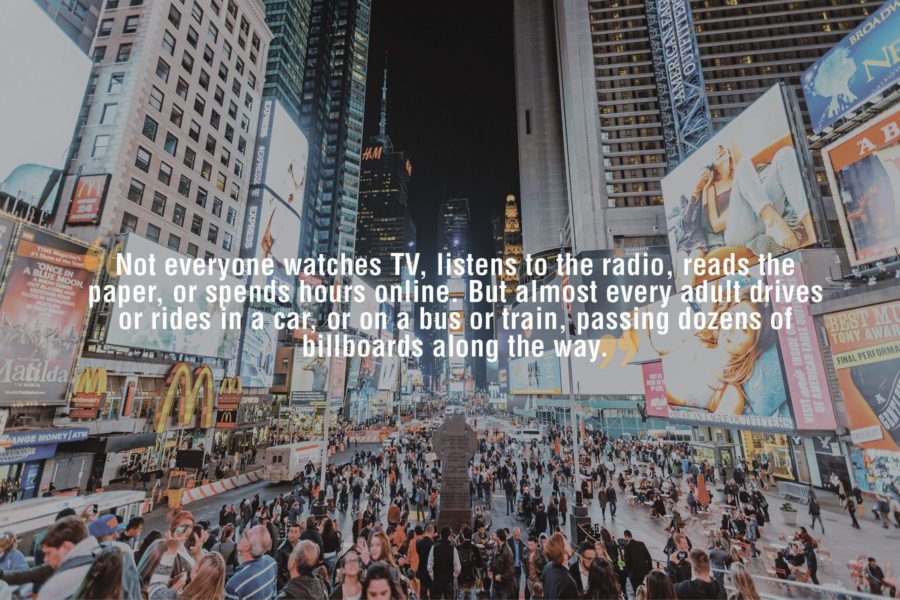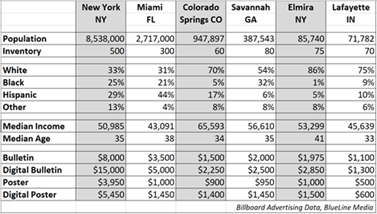Billboard advertising, also known as out-of-home (OOH) or outdoor advertising, is as old as the printing press, but even in our age of instant and global online communication, the old-fashioned billboard ad remains one of the most popular and effective forms of visual marketing, accounting for 6 percent of global advertising.
Even the tech titans Alphabet, Amazon, Apple and Facebook are top spenders on OOH advertising, as are the media giants Comcast, Disney, HBO and Netflix. This is because they know that there is no more effective way to bring a new message to the attention of a targeted local audience.
Six Primary Cost Factors
The cost of billboard advertising varies widely according to six primary cost factors, some of which are fairly standardized, and some of which are highly dependent on where the billboard is located. The same billboard could rent for $300 per month in a rural market, $2,000 in a mid-sized city and $10,000 (or more) in a major urban center.
- Size – Standard sizes range from a Junior Poster (6’ x 12’) to a Spectacular (16’ x 60’).
- Format – Standard formats include printed billboards, digital billboards and mobile displays.
- Length of Contract – Billboard space rental is typically priced in four-week periods.
- Circulation – Los Angeles (pop. 4 million) costs more than Los Alamos (pop. 12 thousand).
- Demographics – The age, gender and income of the target audience can influence the cost.
- Impressions – Visibility, speed limits and traffic density influence effective impressions.
Up Front Costs
In addition to the rental cost of an outdoor sign, the advertiser will have costs to design, print and install the billboard. A professional designer will cost from $100 to $500 per hour, and the material cost is based on the size of the billboard.
How much does a billboard cost to produce? For example, a Junior Poster requires 72 square feet of material, while a Bulletin uses 672 square feet. Typical material cost is $1.50 to $2 per square foot. Installation may be included with the price of fabrication, or there may be a separate charge for mounting the printed billboard.
Materials for Printed Billboards
The most common material for traditional billboard printing is polyvinyl chloride (PVC). In recent years, polyethylene (PE) has also become popular, as it is recyclable, while PVC is not. PE is also lighter than PVC, so it costs less to ship.
Digital Billboards
Most billboard sizes are also available as digital billboards, which use bright LED displays, color and motion to attract attention day or night. Digital billboard advertising adds a premium of 20 percent to 40 percent to the cost of billboard rental.
For example, in Savannah, Georgia, the median four-week rental cost for a high traffic printed vinyl bulletin is $2,000, and a printed vinyl poster is $950. For digital billboards in the same location, the rental cost is $2,500 for a digital bulletin and $1450 for a digital poster.
Digital billboards also make it possible for the advertising company to rent segments of time on the same billboard to multiple clients. Blip Billboards will rent display time for as little as $5 per day, allowing small business marketers to direct outdoor advertising to their target audience at very low cost.
Standard Billboard Dimensions
The most familiar billboard size seen on the highway is referred to in the industry as a Bulletin. The standard Bulletin sizes are 14’ x 48’, 10’ x 40’ and 10’6” x 36’. Because their size in relation to their distance from traffic is ideal for billboard advertising, Bulletins are used on the most important primary commuting and inter-city traffic routes. A typical Bulletin will be capable of 20,000 to 50,000 impressions per day.
The next smaller standard billboard is a Poster, sometimes called a 30 Sheet. The most common size is 12’3” x 24”6’, although some Posters are 10’.5” x 22’.8”. The average Poster can deliver 10,000 to 20,000 impressions per day.
The smallest standard billboard is a Junior Poster, also known as an 8 Sheet. With standard dimensions of 6’ x 12’, the Junior Poster is the most affordable, but is also the least visible from a distance. A Junior Poster can deliver 8,000 to 12,000 impressions per day.
Spectacular in Size…and Cost
In a very important location, a billboard advertiser may choose a very large Bulletin size known as a Spectacular, which measures from 16’ to 20’ in height and up to 60’ in width.
A Spectacular may also include layers of special execution, such as 3-D embellishments, digital screens, audio effects and even interaction with mobile devices.
This is the type of billboard you might see in Times Square in New York, on Sunset Boulevard in Los Angeles or on The Strip in Las Vegas. These billboards are capable of up to 100,000 impressions per day, and the cost of billboards in this category reflects their super-size.
Billboards for Special Applications
- Wallscapes are billboards mounted in a highly visible location on a prominent building. They are often visible from a distance by many viewers.
- Street Furniture is the catch-all name for the category of OOH displays designed for bus shelters, benches, newsstands, phone kiosks and other displays that have been customized for advertising space in high-traffic urban locations.
- Transit Signs are displays designed for rail and subway stations, airports, taxis, buses, panel trucks and other mobile applications.
Location. Location. Location.
Even within the same city or along the same highway, the exact location of a billboard can have a strong influence on its capacity to deliver impressions, and to command a higher price.
The best sites for a billboard are commuter routes, where the posted speed is 30-45 mph and the traffic becomes congested enough at drives times to slow drivers even further.
Inter-city routes can have just as many cars, but speeds of 55-70 mph, and the need to concentrate on driving make them less desirable for advertising impressions.
What Makes a Premium Location?
Certain locations are so ideal that they can charge a location premium. For example, when Kubota was seeking to hire experienced heavy equipment engineers, it put its invitation on a billboard facing the employee parking lot at the headquarters of Caterpillar.
In San Francisco, one premium location is at the terminal end of the Bay Bridge. Each day, more than a quarter million passengers have to slow (or stop) as they approach the city, absorbing advertiser messages that are targeted for their demographic characteristics.
Visibility, Approach and Dwell Time
In an ideal location, a billboard is visible at long distance, and an unobstructed approach keeps the billboard in view until the viewer has passed. Dwell time refers to the length of time the billboard remains visible to driver or passenger.
Although a driver can see billboards on both sides of the road, those located on the same side as the driver are more effective and command a better price.
The best locations are also relatively free of distractions tgat would make a driver look away from the direction of the billboard. Distractions might include traffic control features such as intersections, information signs and highway exits, or points of interest such as long side views or local attractions.
Population, Demographics and Billboard Cost
Below are some examples of the correlation between population density, inventory of available billboard spaces, market demographics and billboard cost. Costs shown are for a typical printed bulletin, digital bulletin, printed poster and digital poster.
How much does a billboard cost in New York?
In the small city of Elmira, the median rental cost for a printed vinyl Bulletin is $1,975, while a Digital Bulletin is $2,850. In New York City, the median rental cost for a printed Bulletin is $8,000, and a Digital Bulletin is $15,000.
This difference in billboard cost is mostly about the very large difference in population, which determines potential advertising impressions. The population of New York City is 100 times larger than Elmira. An advertising company will set its pricing based on a cost per thousand impressions, which is referred to in the industry as Cost Per Mille, or CPM.
Cost Per Mille (CPM)
Most advertising media, from billboards to websites, are priced according to Cost Per Mille (CPM), which estimates the cost per thousand impressions made by the advertisement, based on circulation.
While a newspaper measures circulation based on the number of copies delivered to readers, and a website uses the number of visitors, billboard circulation is based on transportation counts and population.
Monthly rental prices for billboard advertising space are based on the number of people who will see the ad. This data on circulation and impressions in specific locations are developed by market research companies using public data on cars and pedestrians, as well as private market surveys.
The location of the sign may be rated according to visibility, the speed of traffic and how long the sign is visible to an approaching viewer. Demographic data helps the advertiser understand who is seeing the ads in terms of their age, gender, ethnic breakdown and average earnings. Demographics can have a strong influence on pricing because advertisers are seeking to target viewers with specific buying habits and targeted levels of income.
Are billboards worth the cost?
When we ask: “How much does a billboard cost?”, the answer must include cost-benefit analysis. Is the billboard advertising cost for a particular business low in relation to the value of new business generated? In most markets, billboard advertising cost is very low in relation to other advertising options.
According to the Out-of-Home Advertising Association of America, billboard advertising returns an average of $5.97 for every $1 spent. Billboard advertising cost versus return compares very favorably with TV advertising ($6.15) and is substantially more effective than radio ($4.95) or print advertising ($4.12).
In recent years, online marketers have also discovered that integrating billboards ads with web addresses and Facebook pages can substantially increase the effectiveness of digital search, social media interaction and online advertising.
Strong Impact on a Local Audience
Not everyone watches TV, listens to the radio, reads the paper or spends hours online. But almost every adult drives or rides in a car, or on a bus or train, passing dozens of billboards along the way.
The average American spends 30 to 90 minutes a day commuting, with part of that time exposed to the roughly 400,000 billboards that populate our highways and rail transit routes.
Surveys show that 71 percent of drivers and passengers are conscious of having looked at a billboard recently, and over 50 percent say that in the past month, they have engaged with a business they first noticed on a billboard.
For a business with a local market, such as a restaurant, law office or retail shop, the ROI for billboard advertising can be extremely high. For businesses requiring more than a few seconds to make their value proposition, the benefits may not be there.
However, when a clever ad designer can keep the pitch short and simple, adding arresting images and eliciting laughter or other emotions in the viewer, almost any business can convert billboard impact into more walk-in customers or website clicks.
For all your business insurance needs, Higginbotham is here to help. Speak to a specialist to get the coverage that’s right for you.






